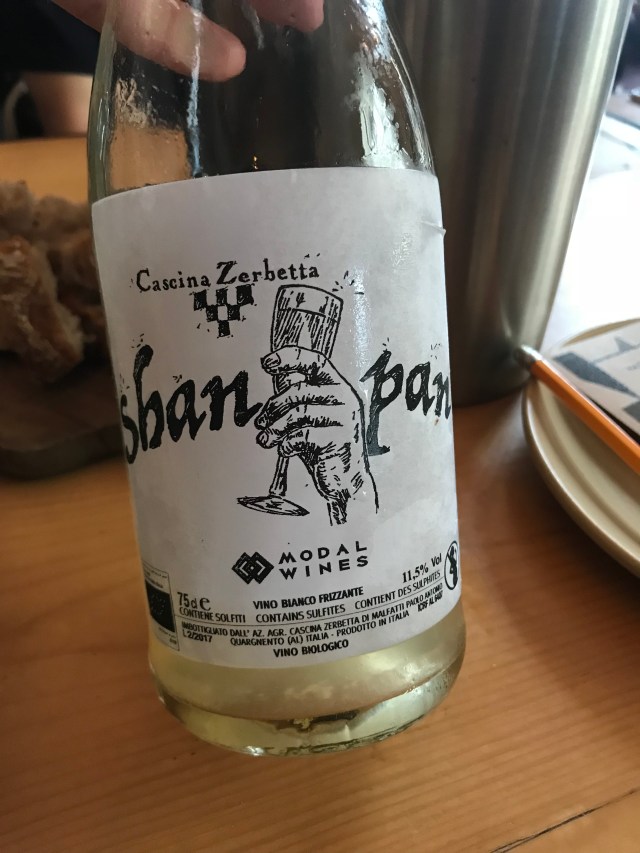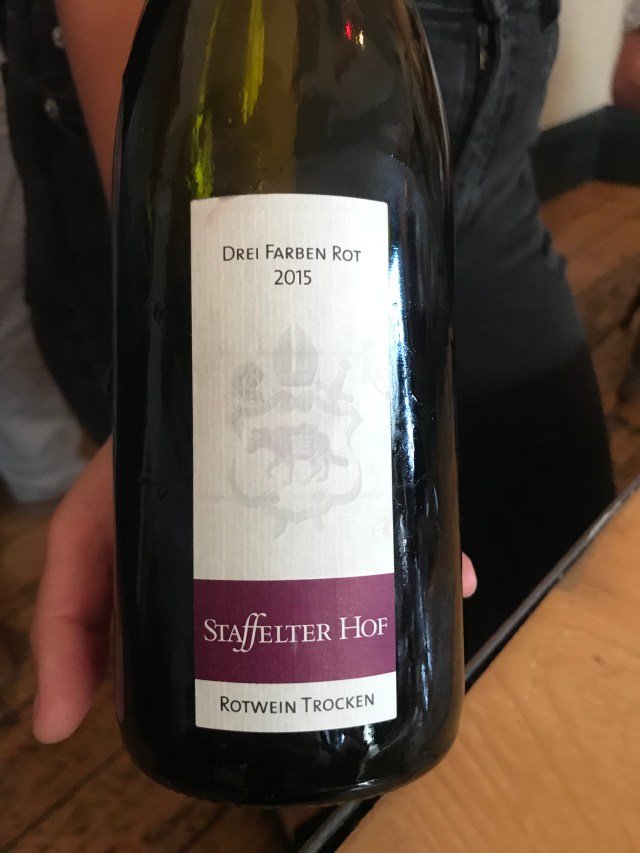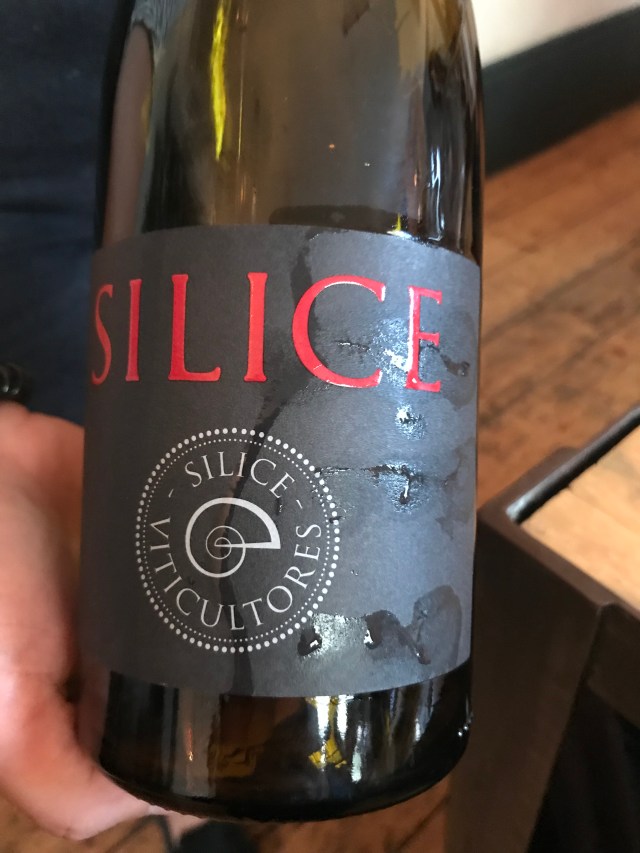Last night, Nicolas Rizzi, founder of Modal Wines, undertook a tasting at Plateau in Brighton, introducing a few of the wines from his portfolio, and discussing how provenance affects the wine in the bottle. As well as importing a very exciting small range of wines, Nic is a very entertaining speaker, which led to a great evening of conversation, with an engaged audience, rather than just a lecture. These Plateau tastings are always really good (and amazing value at £20 with wines, water and nibbles included), and this was no exception.

Ania from Plateau and Nic from Modal, ready to roll
Shan Pan 2017, Cascina Zerbetta (Monferrato, Piemonte, Italy)
Shan Pan looks like a pétnat. In fact it looks like a Colfondo Prosecco. What it is could be described as unusual on two counts. The first is that this is made from Sauvignon Blanc, in a region where you would be more likely to find a string of other, local, white varieties, maybe Moscato, Arneis or Cortese. The second unusual fact about this wine lies in its production method, whereby late harvest grapes with high sugar content are added to create a second fermentation on lees, in bottle.
This is a natural wine with no added sulfites, bottled without filtration. The bottle therefore contains a lot of sediment. Some people prefer to allow these wines to stand for a day or so, enabling the yeast deposits to settle and the wine to be poured clear. Nic insists that you invert the bottle to mix up the contents, so that (rather like Orangina in the old days) the “bits” are distributed throughout the wine.
The result is a wine of texture, very cloudy, yet also showing purity. It has good acidity but is not too tart. The bubbles are very fine and intense. I jokingly described it as a breakfast wine. Only 11.5% abv means that is not completely fanciful. It is nice and dry, fun but not wholly frivilous.

Deviner 2015, Slobodne (Zemianske Sady, Carpathians, Slovakia)
Slobodne is an estate typical of the history of this region in Slovakia’s western hills, about an hour from Bratislava. During the Communist Era these vineyards were confiscated and put under state control. Their return to family ownership was the result of proof of ownership having been hidden away and fortuitously rediscovered on the fall of the Communist regime. The first vintage of the new era at this estate was only 2010, and immediately the family decided to go down a “natural wine” path.
Devin (note spelling) is a very special Slovakian grape variety. “Deviner” is a blend of Devin (whose parents are Traminer and Roter Veltliner) and pure Traminer. This is a skin contact wine, and in the 2015 vintage the blend is 50:50 of both varieties. Maceration time is actually six weeks, although the fruit is 100% destemmed, and yet the colour is more straw/pale gold than orange. The crazy aromatics, suggestive of sweet grapefruit with a touch of lime and peach, almost lead you to expect a sweet wine, yet it is bone dry.
At the London Wine Fair I tasted both the 2014 and 2015 vintages, the former containing 70% Traminer, and I said I preferred the 2015. Last night it was exceptional. This is a very fine estate in the making.
Primario 2016, Atelier Kramar (Goriska Brda, Slovenia)
We may require a quick geography lesson here. This estate lies near the western border of Slovenia, contiguous with the Italian region of Friuli. The political border splits what is really one geographical region, but the geology north to south is not identical. The Slovenian sub-regions run from Brda in the north, through the Vipava Valley, to Karso or Kras in the south (Carso in Italy). Brda doesn’t have quite the same chalky soils as Karso/Kras, but something called “Ponca“, Eocene sandstone marl with a high density of marine fossils.
The grape variety for this orange wine (and this one really is orange) is Rebula (aka Ribolla Gialla in Friuli). Said to have been brought to the region from Greece in the Thirteenth Century, it generally gives quite floral wines with good acidity. The soils of the region can perhaps be said to add a certain steely backbone to this wine, along with a noticeable touch of salinity.
It only sees three days on skins, but you can almost smell the texture. Fermented in stainless steel and then aged in large old slavonian (sic) oak, it remains an elegant wine, despite its structure. It has great length. Alcohol comes in at 13%. I think, personally, it would be a good choice to go with cheese.
This kind of wine for me is just so exciting, and indicative of how the whole of this region, both on the Italian and Slovenian sides of the border, is making distinctive wines of undoubted class. After all, we are not far from where Italy’s Josko Gravner made his famous u-turn and discovered Georgian qvevri, which arguably kickstarted the modern orange wine revolution less than twenty years ago.
The labels for Primario, and the rest of the range, are created by the couple who own Atelier Kramar, Katja and Matjaz (she a painter and he a sculptor, who met whilst creating art in Venice), so the labels express their art as well as their wine.

Drei Farben Rot 2015, Staffelter Hof (Mosel, Germany)
Staffelter Hof is in Kröv, on part of the famous stretch of the Mosel, between Erden and Taben-Trarbach. It’s a long established estate (with rooms to rent, it seems, though I’ve never stayed with them), founded in 1805 (purchased from Napoleon, no less, though I imagine he had come by it via means other than purchase).
Natural wine is not really so typical in the Mosel Region, so what happened? As is so often the case, the next generation simply wanted to move in a different direction. Taking over in 2005, the estate became organic in 2010 and experiments with minimal intervention wines have followed.
In such a classic region for traditional Riesling (which I must say I love, I’m not a fundamentalist over what I drink), it is not only unusual to see an established estate working naturally, but the region as a whole is also not so well known as a source of red wines in Germany (although there are some here). This was my first wine from this estate.
The three grape varieties in question (from the name) are Frühburgunder (50%), Spätburgunder (aka Pinot Noir, 40%) and Regent (10%). Regent can be found in the British Isles, as indeed can Frühburgunder, under the French version of its name, Pinot Précose. It is an earlier ripening, darker-skinned, mutation of Pinot Noir (as its name suggests, Spät…burgunder being the later ripening variety), and it is estimated that varying amounts of “Pinot Noir” in the UK could be Pinot (Noir) Précose.
All three grapes are picked and fermented separately for this cuvée, and the character of the Frühburgunder is said to add the nice touch of spice this wine has. If I say it is quite lean, that might give the idea I’m making a criticism. That could not be further from the case. Leanness here goes beside freshness, a nice edge and line of acidity, all underpinned with sappy, juicy, fruit. Perhaps I mean that it is quite taut. It’s a nice wine, and very clearly a natural wine without any signs of overt volatility. A very refreshing light-to-medium-bodied red for summer. Drink cool, perhaps, but not chilled.

Silice 2016, Silice Viticultores (Ribera Sacra, Spain)
Ribera Sacra is the terrifyingly beautiful region of Galicia along the steep valleys of the Rivers Sil, Bibei and Miño in Northwestern Spain. It only became recognised as an appellation in 1996, but it is swiftly becoming fashionable, even more so in time than neighbouring Bierzo, perhaps. This wine exemplifies why.
Silice reminds me of the Mencia grape variety as it was when I first discovered it, fragrant, juicy, and not too heavy. Bierzo brought fame for Mencia, justly so as it is a lovely variety. But the big names in Bierzo seem to have increasingly opted for the oaked version of Mencia. In Silice, we have a wine of contrast.
Ribera Sacra is a land of small growers, many of whom have recovered once neglected vineyards of considerable age. But if you were to run your finger down a list of these producers, you’d be unlikely to recognise any without a degree of local expertise. Bierzo certainly has some (super)star names now. But if you were to select a trio of names who will become well known, it must be Fredi Torres, and Carlos and Juan Rodríguez (Rodríguez is a name which appears time and time again in this DO, and there are at least three other Rodríguez’s making very exciting wines here).
Silice is biodynamic, and made from around 80% Mencia, with 20% made up from several local varieties. The key is in vine age (sixty-to-eighty year old vines, with some up to 120 years old), and winemaking. Although winemaking is very much hands-off, the decision to harvest early when the skins are thinner, and to give the grapes a light extraction (no punchdowns, except by hand, gently, to keep the cap moist) gives us a wine which first of all strikes as so beautifully fragrant.
I said terrifyingly beautiful. The slopes here are ridiculously steep and high up, at altitude. The land can only be worked arduously, by hand. Few but the most dedicated will take these vineyards on, and these are generally people who would eschew synthetic sprays and winemaking additives anyway, but the truth is that few could actually afford them. We therefore benefit from wines of great purity in more than one sense of the word.
Mencia, handled like this, is capable of creating a bouquet of intense but almost ethereal violets with hints of rose petal. If you really get into it, it’s quite meditative. Add to that a low alcohol level of 12% and the fresh acids of grapes which have avoided excessive hang time, and the result feels like a long lost friend – Mencia as I first ever tasted it. I’ll be drinking more of this, for sure. Just a few quid over £20, almost a bargain.

BFF 2015, Joiseph (Jois, Burgenland, Austria)
This estate, named partly after its location at the northern end of the Neusiedlersee, was created by Luka Zeichmann around two years ago. It is almost impossible to believe that this young twenty-six-year-old’s first vintage was at the age of twenty-four. This estate is relatively new to me, but I am keen to sample as much as possible of this young man’s wine.
Luka began with just one hectare of vines, from which he made five wines. He now, since 2017, thankfully, has managed to extend his holding to 3ha. But before things get better for those seeking his wines, they will get worse. The terrible frosts which hit Burgenland in 2016 reduced the whole production here to 660 bottles (in May 2016 there were six consecutive days when the temperature near Jois went below minus five Degrees Celsius, and almost no one with vines throughout the wider lakeside region avoided near devastation, as those of you who read my Gut Oggau Family Reunion piece last September will be aware.
I don’t know how this affected the morale of this unassuming, reluctant, star. His desire to keep things quiet even stretches to him professing a desire not to own a smartphone (although Nic has told him about how his bottles are all over Instagram, and I did notice he now appears to have a Facebook page).
What does BFF actually taste like, then? What makes it different and special? It is actually made from a slightly softer skinned clone of Blaufränkisch. It has deliciously tangy fruit, and is quite spicy, with classic black pepper notes. Some modern Blau can be over-oaked, over extracted and ponderous, not to mention in need of some tannin softening, via extra cellar time.
At just 12.5% alcohol (check out some of the more flashy examples around), this has great acidity and is relatively light on its feet by comparison. I am a firm supporter of this style of Blaufränkisch, not so much light as wonderfully balanced with a tension between sweet fruit and savoury spice.
Luka only exports to the UK and Sweden, so we are damned lucky to be able to grab some of these. Of course, you can travel to the usual natural wine bars in Vienna to seek out a bottle or two, or you can grab whatever you can from Modal. If you rock up in Jois, you may well be disappointed.
Just a note on the labels. The front label is always the same, simple and uncommunicative, at least in terms of text. The back label gives the explanation, and each cuvée has a colour-coded wax seal. BFF is bottled as a “Landwien”, a choice made by many of the local producers of natural wines, whose bottles are often quite different in style to those under the Burgenland DAC sub-regions.
I said I enjoyed the event, and I’m sure you can tell that I enjoyed the wines. I did put my money where my mouth is and order a few bottles, and I am back at Plateau for dinner on Saturday, when I am hoping to drink another Modal wine off the list. It was my second taste of a selection from Modal in as many weeks, as I had already tasted five out of these six wines at the London Wine Fair. I’m pleased that my favourable opinion was only reinforced at Plateau.
Modal Wines is part of the Out the Box group of small, like minded, young importers and their next tasting event (for trade and press only) is at Shoreditch Town Hall on 25 September this year. Anyone entitled to go should try to make it. Along with Modal you can taste Red Squirrel, Basket Press, The Knotted Vine, Maltby & Greek, Uncharted Wines, Swig, and Nekter. That’s a lot of fantastic, innovative, unusual and downright shockingly good natural wine.








I do not get the misconception that there are no natural wines in the Mosel. From my numerous visits to the region and the conversations I had with winemakers, there are plenty of them who work naturally. They do not use it to promote their wines as actively as some others, so maybe that is at the source of the misconception. Alternatively, it is because I find that they do not adhere to the taste profile that many people come to associate with natural wines.
Having tasted the wines of Staffelterhof myself at various occasions (always the whites), I get that your note on the red is not so thrilling. Fruhburgunder is not a variety that is suitable for the Mosel climate as well I think. There are more and more winemakers who make good spätburgunder though, but undoubtedly difficult to find abroad.
LikeLiked by 1 person
I do know of one or two natural Winemakers in the region. Trossen is one whose wines I have admired, though only have one example in the cellar right now. I know I need to explore more.
I did think the S-Hof wine was nice, though not didn’t buy any. A good picnic wine. I do enjoy German reds though, and I generally grab any Mosel examples I see, just to give them a try. As you rightly say, you don’t see many, certainly not in the U.K. But as that German Reds Tasting I went to recently (which I think you saw), we are beginning to see more.
LikeLike
Well it depends on how strict you are on defining natural winemaking. Weiser-Kunstler for example works organically, does not intervene in the vinification, uses wild yeasts for the fermentation and only adds a tiny bit of sulphur at bottling. Same can be said for Peter Lauer for example, or Hofgut Falkenstein. I am quite familiar with the Trossen wines, and while there a couple that I can appreciate, I find them sometimes lacking in finesse, going more to soft instead of zingy, a characteristic that really is a key aspect of Mosel Riesling to me.
LikeLiked by 1 person
Pingback: Out the Box 2018 | David Crossley's Wide World of Wine